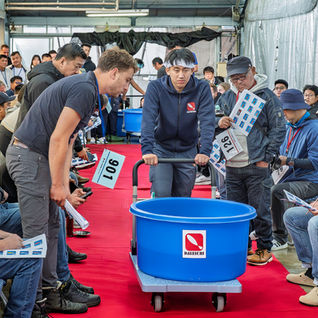Nishikigoi Classification
- Kevin Warren

- May 5
- 6 min read
Updated: Sep 17
In 2022, the Japanese Agricultural Standard (JAS) for Nishikigoi was formally established, marking a significant step in the ongoing evolution of koi classification. Initiated by a proposal from the All Japan Nishikigoi Promotion Association to the Minister of Agriculture, Forestry, and Fisheries, the standard was enacted following careful deliberation by the Council for the Japanese Agricultural Standards. This landmark initiative defined official terms and classifications for 21 recognized Nishikigoi varieties. Its purpose was to bring clarity and consistency to terminology within the koi community—both in Japan and abroad—reinforcing the cultural and commercial significance of these “Living Jewels.”
JAPANESE AGRICULTURAL STANDARD
(Tentative Translation)
Nishikigoi Classification
Date of Establishment: 2022-02-24 JAS
0020: 2022
Ministry of Agriculture, Forestry and Fisheries
NISHIKIGOI-Vocabulary
Scope
This document defines terms and definitions for nishikigoi.
Normative references
The following documents are referred to in the text in such a way that some or all of their content constitutes requirements of this document. The latest edition of the referenced document (including any amendments) applies. JIS Z 8102, Names of non-luminous object colours
Classification
The classification of terms shall be as follows:
a) general;
b) nishikigoi variety.
Terms and definitions
The following terms and conditions apply
General Terms and Definitions
Nishikigoi
General name of carp (Cyprinus Carpio) with appearance characteristics for appreciation.
Original Japanese Text: 錦鯉
Nishikigoi Variety
Type of Nishikigoi improved and selected according to certain appearance characteristics, and classified as the same unit.
Note 1 to entry: The variety differs from the biological species.
Appearance Characteristics
Characteristic property appearance, such as body shape, body background color, imprints, size (total length, body height, weight, etc.) and how it shines.
Note 1 to entry: The body background color is basically named in accordance with JIS Z 8102, but since Nishikigoi has an individual difference as a property of living organisms, it includes the similar colors.
Body Shape
Form of figure of appearance.
Note 1 of entry: The body shape includes such as shapes of scales and an arrangement of scales.
Imprint
Pattern made of a body background color and other partial colors.
Note 1 of entry: The color of imprint is basically named in accordance with JIS Z 8102, but since Nishikigoi has an individual difference as a nature of living organisms, it includes the similar colors.
Nishikigoi Varieties

2001 Kohaku
Nishikigoi with a white body (hereinafter referred to as “white background”), and red or scarlet imprints (hereinafter referred to as “hiban”) across the body.
Original Text to Japanese: 紅白 こうはく

2002 Taisho-Sanshokau
Nishikigoi with a white background, and hiban and black imprints across the body.
Original Text to Japanese: 大正三色 た い し ょ うく

2003 Show-Sanshoku
Nishikigoi with a black body (hereinafter referred as “black background”) and hiban and white imprints across the body.
Note 1: In general, the base of the pectoral fin is on a black background, but in the processs of growth, there are some that change from a a white background to a black background.
Note 2: Show-Sanshoku has continuous parts of black background without imprints (referred to as “utsuri-zumi”)
Original Text to Japanese: 昭和三 色 し ょ う わく

2004 Shiroutsuri
Nishikigoi with a black body and white imprints across the body.
Note 1: Shiroutsuri has utsuri-zumi
Note 2: Shiroutsuri is similar to, but distinguishable from Bekko (no. 2019), since it has a black background
Original Text to Japanese: 白写り しろうつり

2005 Goshiki
Nishikigoi with an Indigo or light blue body, except for the head, a mesh pattern on the entire dorsal part but to an arrangement of scales (referred to as “asagi background”, and hiban on the dorsal part.
Original Text to Japanese: 五色 ごしき

2006 A-Ginrin
Nishikigoi with shiny golden scales (on parts of hiban etc.) or shiny silver scales (on parts of a white background, etc.) having the appearance characteristics of kohaku, taisho- sanshoku or showa sanshoku
Original Text to Japanese: 銀鱗 ぎんりん

2007 B-Ginrin
Nishikigoi with shiny golden scales (on parts of hiban etc.) or shiny silver scales (on parts of a white background, etc.), but not classified as A-Ginrin.
Note 1: A-Ginrin and B-Ginrin are together called “kinginrin”
Original Text to Japanese: 銀鱗 ぎんりん

2008 Kawarigoi
Nishikigoi which is not classified into the varieties specified in 2001 to 2007 and 2009 to 2021
Note 1 to entry: At Nishikigoi competitions, those with remarkable appearance characteristics and those with many appearance characteristics are classified as Kawarigoi. Once those classified as kawarigoi become remarkable popular, a new conventional name is given. Karaigoi with conventional names are, for example, beni-kikokuryu and ochiba-shigure.
Note 2 to entry: There is a possibility that those classified as kawarigoi will be independent as another variety in the future.
Original Text to Japanese: 変わり鯉 かわりごい

2009 Kujaku
Nishikgoi with an adagio background, hiban on the dorsal part, and a shine whole body.
Note 1 to entry: Some kujaku have appearance characteristics of doitsugoi
Original Text to Japanese: 孔雀 くじゃく

2010 Kumonryu
Nishikigoi which originally has a black background, with a black cloud-like pattern which seems like having emerged across the whole body, as white parts increased during the growth process; and having appearance characteristics of doitsugoi.
Note 1 to entry: Some kumonryu change their black cloud- like pattern frequently in a short period of time due to changes in the environment.
Note 2 to entry: Some kumonryu have hiban.
Original Text in Japanese: 九紋竜 くもんりゅう

2011 Doitsugoi
Nishikigoi with almost no scales on the whole body, having their skin exposed.
Note 1 to entry: Edible carp bred in Germany were imported to Japan and crossed with various varieties of Nishikigoi, resulting in Doitsugoi. Since they strongly inherit appearance characteristics genetically, many nishikigoi varieties with appearance characteristics of doitsugoi have been produced.
Original Text in Japanese: ドイツ鯉 どいつごい

2012 Hikari-moyo
Nishikgoi with imprints across the body other than a black background, and a shiny whole body.
Original Text in Japanese: 光り模様 ひかりもよう

2013 Koromo
Nishikigoi with hiban across the body and the tips of scales on the hiban dyed indigo or black in a half moon shape.
Note 1 to entry: Those with the tips of scales on the hiban dyed in indigo a half moon shape, are called “ai-goromo,” and those with the tips of scales on the hiban dyed black in a half moon shape, are called “kuru-goromo” or “budo- goromo.”
Note 2 to entry: Koromo is similar to , but distinguishable from Goshiki, since it does not have an adagio background.
Original Text in Japanese: 衣 ころも

2014 Tancho
Nishikigoi with a circular form of hiban on the head.
Note 1 to entry: Circular imprints may be imprints of a color other than scarlet.
Original Text in Japanese: 丹頂 たんちょう

2015 kikari-utsuri
Nishikigoi with a black background, imprints across the body and a shine whole body.
Note 1 to entry: Kikari-utsuri has ustsuri-zumi
Original Text in Japanese: 光り写り ひかりうつり

2016 Hikari-muji
Nishikigoi with no imprints across the body, and a shiny whole body.
Note 1 to entry: Some cultivars of hikari-muji have conventional names such as orange-gan, platinum-icon and matsuba-ogon.
Original Text in Japanese: 光り無地 ひかりむじ

2017 Shusui Asagi
Number 2018 with appearance characteristics of doitsugoi.
Original Text in Japanese: 秋翠 しゅうすい

2018 Asagi
Nishikigoi with an adagio background, and in general, with hiban on the abdomen.
Original Text in Japanese: 浅黄 (あさぎ)

2019 Bekko
Nishikigoi with a white, yellow or red body, and clustered black imprints shaped like spots across the body.
Note 1 to entry: Those with a white body are called “Shiro Bekko”, those with a red body are called “aka Bekko”, and those with a yellow body are called “ki Bekko.”
Note 2 to entry: Bekko is similar to, but distinguishable from hiutsuri and kiutsuri #2020, since it has not a black background.
Original Text Japanese: べっ甲 べっこう
2020 Hiutsuri and Kiutsuri
Nishikigoi with a black background, and scarlet or yellow imprints across the body.
Note 1 to entry: Hiutsuri and Kiutsuri have utsuri-zumi
Note 2 to entry: Those with scarlet imprints are called Hiutsuri, and those with yellow imprints are called kiutsuri.
Note 3 to entry: Hiutsuri and Kiutsuri is similar to, but distinguishable from Bekko, since it has a black background.
Original Text Japanese: 緋写り 黄写り ひうつきり
Hiutsuri Nishikigoi Kiutsuri Nishikigoi

2021 Muji
Nishikigoi with no imprints across the body
Original Text Japanese: 無地 (むじ)
Ghibli Images by KoiGhibli, Instagram










